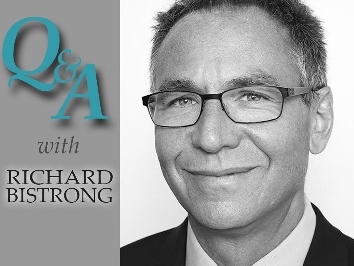
This week Maurice Gilbert, publisher of Corporate Compliance Insights and managing partner of Conselium Executive Search, interviews Richard Bistrong about Front-Line Anti-Bribery LLC.
 Maurice Gilbert: Well Richard, this is now our third Q&A. Thus, given that our last chat was in October, has anything changed with respect to your perspective of anti-bribery risk and compliance?
Maurice Gilbert: Well Richard, this is now our third Q&A. Thus, given that our last chat was in October, has anything changed with respect to your perspective of anti-bribery risk and compliance?
Richard Bistrong: Thank you Maurice, and it is always a pleasure to engage with you and the Corporate Compliance Insights team. What I continue to observe is the rising tide of investigations, settlements and enforcement actions, such as Alstom, Petrobras, and now the upcoming Sigelman (PetroTiger Ltd.) trial. All of these events, and I use them only as examples, demonstrate some need to continue to examine current compliance models in the context of front line behaviors. In other words, are we really considering the field level calculation to “engage in” or “refrain from” corrupt transactions from a behavioral and organizational perspective?
MG: Can you explain that in greater detail?
RB: Sure. As fellow CCI Contributor Matt Ellis states in How to Pay a Bribe (2014, Wrage), “corruption is a crime of opportunity. People pay bribes by exploiting weaknesses.” Indeed, and Matt’s line has become my “go-to” when I reflect on bribery as a crime of behaviors, which at some level, involves at least two parties who have determined that the benefits of corruption outweigh the risks and consequences of getting caught. Thus, much of my writing that you referred to addresses just that, the thinking at the front line. However, in my writings I have recently dived into a rich academic field of behavioral and organizational research, pertaining to ethical decision making, which has great relevance to the field of anti-bribery compliance.
Thus, much of my work focuses on taking such research, like my recent CCI post Culture Corrupts, especially where it provokes a “that was me” moment, and trying to bring it into the anti-bribery compliance stream of thinking. As Dr. Roger Miles, Behavioral Risk Lead, Thomson Reuters, stated in a White Paper, Risk Culture and Conduct Control: Time for a More Enlightened Approach:
“Shouldn’t the designers of financial controls spend some time looking at the dark side? Instead of regulating by defining and enforcing some formulated version of normal behavior, a better approach for supervisors seeking to regulate conduct might be to identify the pathologies of “bad behavior.” What are its warning signs, its leading indicators? Can these be found in financial reports? (Hint: No, they cannot). Where do we need to look?”
Maurice, I know it sounds odd to ask, but is the compliance community spending enough time looking at the dark side? Are they bringing in their teams from high-risk (low integrity) regions, and asking, “Tell us what you face in your work in terms of corruption risk and how is that impacting your thinking?” Are they listening to how their front-line personnel might be rationalizing or contemplating unethical behavior, and considering how they can address those dynamics before they end up as corrupt decisions? Rationalizing bribery involves multiple illusions, misperceptions and distortions, but you can’t address them if your not probing, asking and listening. Worse, companies, through “unspoken messages,” as transmitted via compensation plans and financial forecasting, might actually be amplifying those elements instead of diluting them.
It is one thing to think of bribery as a “win-win” at the field level, as I often reflect, but it is another decision to engage. Maurice, it is a often a struggle at the field level, and engaging with personnel as to how they are pondering ethical decisions, as opposed to them looking for cues while in their territories (which might be the worst place to seek behavioral confirmation), might just be the right “tipping point” to keep someone in an ethical comfort zone as opposed to “going local” when they hit their territories.
Just take a look at those who have been convicted of bribery: most were well educated and compensated. Why would anyone risk his or her own liberty to engage in corruption? Taking out the “rogue employee” script is not helping anyone, and as we see, it is certainly not diminishing the level of bribery that we see through enforcement actions and investigations. For example, I certainly understand the “dotted line, straight line” debate as to the compliance reporting structure is organizationally essential, but to someone at the front-lines who is contemplating paying a small bribe the day before a fiscal quarter ends to close a transaction, it is a non-event.
MG: So given the lack of focus that you see in terms of behaviors, where do you see your own intersection with the compliance community?
RB: Maurice, I remember one of our first conversations, not long after I was released from the Prison Camp at Lewisburg and you asked me of my plans. I shared that I would simply write about my experience and perspective, and would engage with those who wanted to hear more. I had neither a financial model nor business plan. It was simply a decision to share my experience and thinking at the time, and to see if it might be a potential learning moment for other groups and businesses. Now, over a year later, where just last week I participated in a webinar across 15 time zones, I think there is relevancy. I don’t know what to call it, as I approach this field not from a legal, audit or investigatory perspective. It’s the intersection between organizational messages, programs and training, and the “sharp end” of those who operate and contemplate on the front lines of business.
What I understand is what it is like to work in a successful public company environment, with aggressive growth forecasts, lucrative incentive packages, and where overseas frontier markets have been identified as growth sectors. I have been through the strategic planning process, rolled forecasts up and down the org chart, and understand that the other end of that process, from a corruption point of view, is where field personnel have been tasked to translate those goals into reality.
Taking that process, and combining it with my own experience, and then layering on the organizational and behavioral research, I think complements the existing field of compliance by addressing the front-line dynamics. Going back to the webinar referenced earlier, as I shared each component of my own rationalizing process, what I heard from the attendees was “how do we train for that,” and “how can we address that.” Those are good questions, and if properly addressed, I believe there are signs that someone is going down the wrong slope of decision-making before the final decision to “engage in.”
Thus, my practice, if you call it that, Front-Line Anti-Bribery, is simple: Lets look at the behavioral warning signs, including forecasts and incentive plans, which can often lead those who struggle astray, and be proactive. Professor Francesca Gino (Harvard), has conducted some engaging research and wrote a book that I wave around at every opportunity, Sidetracked, where she addresses so many of the issues as to “why our decisions get derailed.” I am not playing armchair organizational therapist, but I have experienced enough “that was I” moments while reading these works, to know that they can help those in the field and those who are tasked with supporting them to manage corruption risk. So, why not take that work, share my own experience, and let’s see if it brings value. The fun part is, with each work I read, and my reading “on-deck” shows no end, brings new insight and relevancy. Given that Culture Corrupts had the greatest readership since I started writing, demonstrates that someone out there wants to know more.
MG: What of your speaking?
RB: Well, I am about to start a busy few months of speaking, but of note is a request from Angel Gurria, Secretary General of the OECD. who asked for me to be a member of his High-Level Advisory Group on Integrity and Anti-Corruption of which the first meeting will be March 25-26 at the OECD Integritity Week. Thus, I will engage via video-link with other members in a presentation titled “From Behind the Bribe- A Journey to the Dark Side of International Business,” which will also include a live Q & A with fellow participants. Maurice, going through the experience of surrendering to a Federal Prison Camp in September of 2012, to now being asked by the Secretary General of the OECD to join his High-Level Advisory Group and be a part of Integrity week, marks two bookends, so to speak, of my own personal journey.
But I say that with great humility given my experience, and it is at these moments where I thank those, especially yourself, who reached out to me so early on during my writings, to say “lets talk, I would like to hear more.” There are certain moments that one does not forget, and your initial outreach which provided me with such early encouragement and enthusiasm warrants a heartfelt “Thank You.”
 Richard Bistrong spent much of his career as an international sales executive and currently blogs and consults on FCPA and anti-bribery compliance issues from that perspective. Mr. Bistrong was the Vice President of International Sales for a large, publicly traded manufacturer of police and military equipment, which included residing and working in the UK. Prior to that, he was the Executive Vice President (and founding family member) for one of the largest global manufacturers of bullet resistant armor for the police and military markets. In 2007, as part of a cooperation agreement with the United States Department of Justice and subsequent Immunity from Prosecution in the UK, Mr. Bistrong assisted the United States and other governments in their understanding of how FCPA violations occurred and operated in international sales. Mr. Bistrong’s cooperation, including covert cooperation, and as a cooperating witness, which covered five years, was one of the longest in US white-collar criminal investigations. In 2012, Mr. Bistrong was sentenced as part of his own Plea Agreement, and served fourteen-and-a-half months at a Federal Prison Camp.
Richard Bistrong spent much of his career as an international sales executive and currently blogs and consults on FCPA and anti-bribery compliance issues from that perspective. Mr. Bistrong was the Vice President of International Sales for a large, publicly traded manufacturer of police and military equipment, which included residing and working in the UK. Prior to that, he was the Executive Vice President (and founding family member) for one of the largest global manufacturers of bullet resistant armor for the police and military markets. In 2007, as part of a cooperation agreement with the United States Department of Justice and subsequent Immunity from Prosecution in the UK, Mr. Bistrong assisted the United States and other governments in their understanding of how FCPA violations occurred and operated in international sales. Mr. Bistrong’s cooperation, including covert cooperation, and as a cooperating witness, which covered five years, was one of the longest in US white-collar criminal investigations. In 2012, Mr. Bistrong was sentenced as part of his own Plea Agreement, and served fourteen-and-a-half months at a Federal Prison Camp.
Richard now blogs at www.richardbistrong.com
Mr. Bistrong has a BA from the University of Rochester and an MA in Foreign Affairs from the University of Virginia, including studies at the Institute for European Studies in Vienna, Austria. He is a member of the Society of Corporate Compliance and Ethics. Mr. Bistrong resides in the New York Metropolitan area with his wife and has two children.
Richard can be reached via his blog, LinkedIn, or at Richardtbistrong@gmail.com. He frequently tweets about #compliance and #fcpa topics at @richardbistrong.
Published by Conselium Executive Search, the global leader in compliance search.

